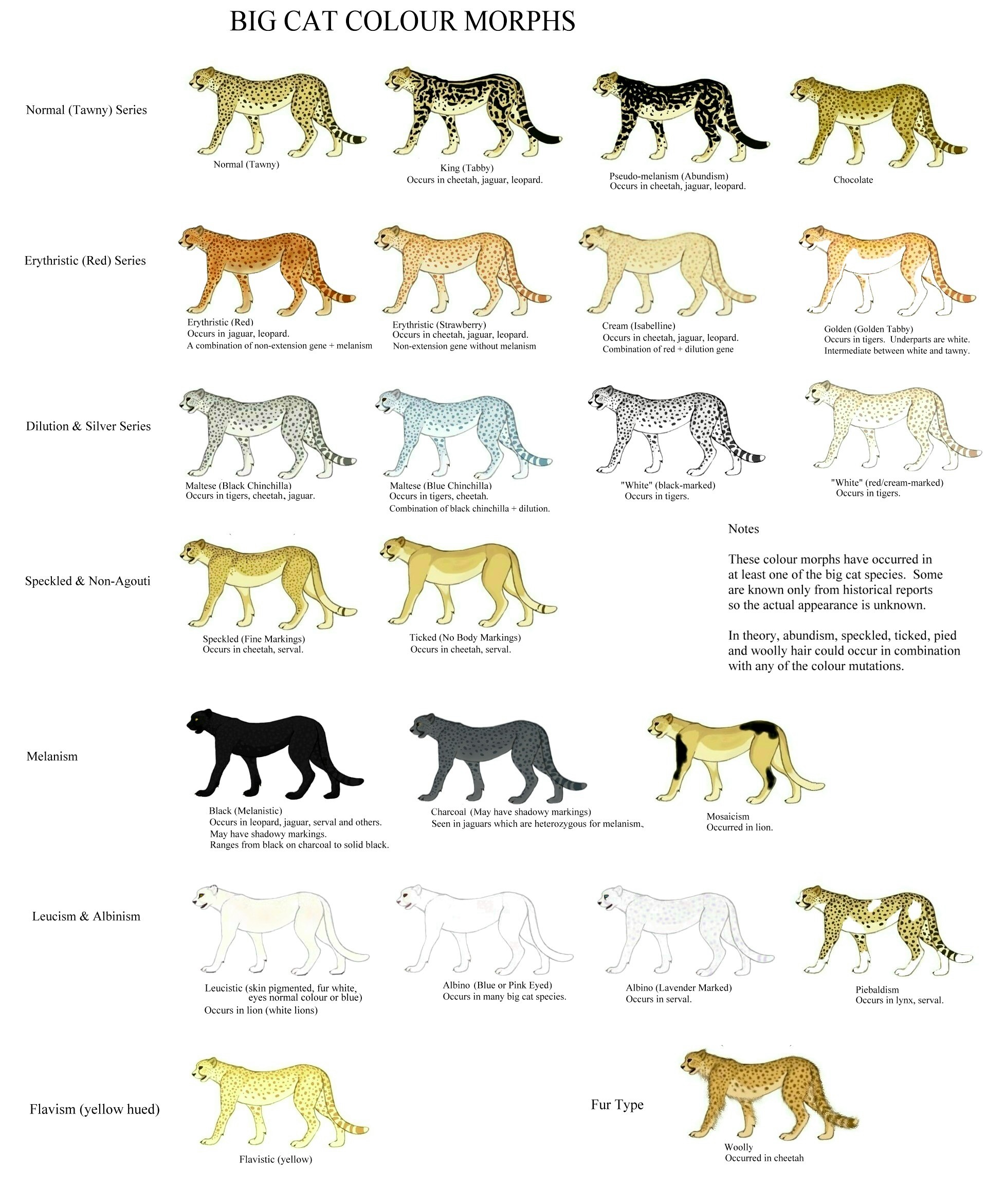
|
MUTANT BIG CATS - TERMS |
Mutants are natural variations which occur due to spontaneous genetic changes or the expression of recessive (hidden) genes. Recessive genes show up when there is too much inbreeding. As well as anomalous colours (listed below), there are abnormally large or small individuals, longhaired individuals, short-tailed or even tail-less individuals.

|
USEFUL GENETIC TERMS |
|
|
Abundism |
Markings are more prolific than usual |
|
Albinism |
Lacking melanin, also known as amelanistic. "True" albinos entirely lack markings and have pale blue ("partial albino") or pink eyes ("true albino"), but there are many degrees of partial albino. Some forms of albino are temperature dependent e.g. the Siamese cat has a form of albinism where pigmentation develops on cooler areas of the body (the head, tail and legs) but is inhibited on the warmer parts of the body. Albinism can also occur in patches. |
|
Anerythristic albinism |
Lacking the red colour. The actual colour and pattern of the animal depends on what other colours are in the pattern. One effect might be a bluish-grey animal. |
|
Axanthic albinism |
Lacking the yellow colour. The actual colour and pattern of the animal depends on what other colours are in the pattern. |
|
Chinchilla |
The hair shaft lacks normal bands of pigment and may be pigmented only at the top. Known also as the "inhibitor" gene because it inhibits production of pigment. There is also believed to be a "wide band" gene because the hair shaft has a wide band of white. |
|
Dilution |
The colour is washed out e.g. black becomes blue (grey), red becomes cream, blue becomes lilac. |
|
Erythrism |
Black pigment is converted to red. The excessive amount of red pigment masks other colours. |
|
Flavistic |
Golden mutation. The overall effect is that of an pale animal photographed in sepia; all colours seem converted to shades of brown or golden-brown. |
|
Golden |
The hair-shaft has a wide band of gold. It is a combination of chinchilla or wide band and normal colouring. |
|
Hypermelanistic |
Having excessive black and/or brown pigment (usually just referred to as melanistic).. |
|
Hypomelanistic |
Having less black and/or brown colour than normal. These animals still have some pigment and may simply look "faded". |
|
Leucistic |
Similar to albino; white, but having dark eyes, some pigmented skin and often having "ghost markings" visible in certain light. |
|
Maltesing |
Another term for dilution of black into blue. |
|
Melanism |
Abnormal amounts of black pigment. |
|
Mosaicism |
Abnormal black patches of skin cells due to cell mutations in the embryo. |
|
Nigrism |
Black markings merge into black areas. |
|
Partial Albinism |
The correct definition is an albino with some residual pigmentation e.g. dark eyes, cream fur or ghost markings. However "partial albino" is also often used to describe animals with albino patches (piebald). |
|
Piebald |
Having white patches. Note: piebald is a normal colouration in some animals, this note only applies to animals which do not normally have black or white patches. In normally dark-coloured animals white patches may be due to albinism affecting certain areas of skin; in normally light-coloured animals, black/dark brown patches may be due to melanism. The patches are due to localised mutations in skin cells during embryo development. If the mutation occurs early in development, the patches are larger. If it occurs later, the patches are smaller. |
|
Pseudomelanism |
Combination of abundism and nigrism i.e. prolific markings coalesce to hid the background colour. |
|
Rufism |
Affects the depth of the red pigment turning it from yellow-orange into deep orange-red. |
|
Schizochroism |
One or more pigments are absent, altering the overall colour and pattern. |
|
True Albino |
Totally lacking in pigment - white fur and skin, no markings, blue or pink eyes. |
|
Tyrosinase-negative Albino |
An albino whose cells lack tyrosinase (an enzyme which synthesises melanin), usually producing a pale yellowish or cream animal with pink-eyes. |
|
Tyrosinase Positive Albino |
An albino not able to synthesise melanin, but able to synthesise tyrosinase, often resulting in a fawn or lavender (platinum) colour. Tyrosinase positive albinism ("partial albinism") is the most common form of albinism. |
|
Xanthic |
Having more yellow colour than normal. |
Textual content is licensed under the GFDL.
For more information on the genetics of colour and pattern:
Robinson's Genetics for Cat Breeders & Veterinarians 4th Ed (the current version)
Genetics for Cat Breeders, 3rd Ed by Roy Robinson (earlier version showing some of the historical misunderstandings)
Cat Genetics by A C Jude (1950s cat genetics text; demonstrates the early confusion that chinchilla was a form of albinism)
For more information on genetics, inheritance and gene pools see:
The Pros and Cons of Inbreeding
The Pros and Cons of Cloning
For more information on anomalous colour and pattern forms in big cats see
Karl Shuker's "Mystery Cats of the World" (Robert Hale: London, 1989 - some of the genetics content is outdated)
|
BACK TO HYBRID & MUTANT BIG CATS INDEX |